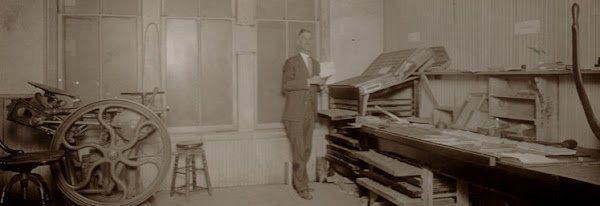Soft ground was perhaps most common in the latter half of the 18th century and first half of the 19th. Traditionally it was used with paper and pencil. A piece of paper is laid over the soft-grounded plate and the drawing made directly onto the paper. The lines produced after etching are soft-edged, like charcoal or crayon. I was really intrigued by the idea of making a plate of an object such as a leaf or feather. I've seen work like this and it reminds me of fossils. It's somewhat haunting, somewhat surreal, impressionistic and moody. I like it.
I went outside and picked a few end branches off the Evergreen tree next to the house. I then had to experiment for quite a while to get the combination of pressure, wax and blotting paper, and blankets to work. I also had to trim the needles off to get a basically two-dimensional flat object that would lay flat and not overwhelm the image by being too dense. This required certain artistic decisions as to how much was too much and where exactly to remove and where to leave alone. Even so, the first several trials on brass key tags produced squashed pine needles, torn waxed paper, pine-juice scented blotting paper, and no need for air freshener. But finally I got it and ran a prepared 16 gauge 2" x 4" copper plate through the press. This was another piece of the old letterpress half-tone I was given. I had to fleck off a few errant pieces of pine needles but it looked pretty good.
I laid the plate in the mordant and a new guessing game ensued: how long to leave it in. This was even more difficult to judge than the line drawing I did on the hard grounded plate the week before. In that case at least all the lines were going to be etched to the same depth. Here they would vary because of the nature of the texture to be reproduced. In the end I left it there for about 20 minutes, checking twice during that time. For the most part I think I got it right. At least I was personally happy with it for my first time.

It was then on to pulling a few proofs and as you can see from the photos I tried it with two kinds of paper. The first type of paper was my old standby unknown brand, approx. 20 lb. laid paper. Since it's the only etching ink I have I used Graphic Chemical Bone Black. I did the final wipe with my hand. I apologize for the poor scans which show strange horizontal lines and make it look like the plate mark is smashed, etc. Once I get a decent digital camera I'll take nice photos instead.

The second proof was done on Graphic Chemical's 150 lb. cotton rag house paper, a few sheets of which I purchased to try out. Again, I used the Bone Black ink. I did the final wipe with old newspaper to get a cleaner background. That rotten scan again! There are no horizontal lines on the actual proof.

I'm not sure whether I like the hand wipe or the paper wipe better; each has its merits I suppose. I'm certain to do a lot of experimenting and of course I'm hoping my technique will improve which will have its own affect. I admit to being very pleased with the way the plate turned out, also somewhat astonished. At some point I will print an "edition" but for now I'm still learning and experimenting.



No comments:
Post a Comment